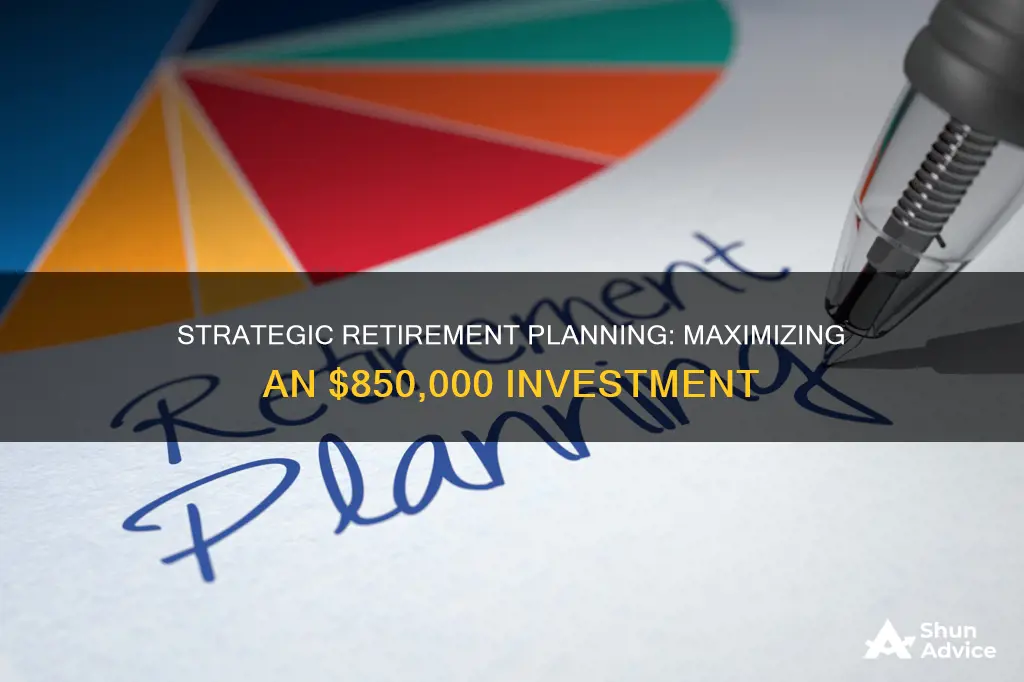
If you're thinking about how to invest $850,000 for retirement, there are a few things to consider. Firstly, it's important to be conservative in your estimates and remember that market volatility can affect your savings. You'll want to take into account all your sources of income, including pensions, 401ks, social security, annuities, and other investments. Utilise online retirement calculators to get an estimate of how long your savings will last based on your spending and investment returns. It's also recommended to visit a financial planner, although they may take a percentage of your savings as a fee.
| Characteristics | Values |
|---|---|
| Retirement savings | $850,000 |
| Retirement age | 41 |
| Investment portfolio | S&P 500 index fund, total stock market index, bonds, individual stocks |
| Investment strategy | FIRE (Financial Independence, Retire Early) |
| Savings calculation | Use a retirement calculator |
| Investment return | Small changes can have a dramatic effect |
| Inflation | Subtract expected inflation from investment return |
What You'll Learn

Investing in an index fund or ETF of the S&P
Index funds are a type of mutual fund or exchange-traded fund (ETF) that tracks the performance of a market index, like the S&P 500. They are passively managed, aiming to replicate the index without active management. This means they have lower costs than actively managed funds. The S&P 500 is one of the most widely followed indices, and there are many funds that invest based on this index.
ETFs are baskets of securities traded on an exchange like stocks. They can be bought and sold at any time, like stocks, whereas mutual funds are only priced at the end of the day. ETFs also tend to have lower costs and are more tax-efficient than mutual funds.
- Fidelity ZERO Large Cap Index (FNILX) - a mutual fund with no expense ratio, meaning lower costs for investors.
- Vanguard S&P 500 ETF (VOO) - a large ETF backed by Vanguard, one of the powerhouses of the fund industry.
- SPDR S&P 500 ETF Trust (SPY) - the oldest ETF, founded in 1993, and one of the most popular.
- IShares Core S&P 500 ETF (IVV) - a large ETF sponsored by BlackRock, one of the largest fund companies.
- Schwab S&P 500 Index Fund (SWPPX) - a mutual fund sponsored by Charles Schwab, a respected name in the industry, with a focus on investor-friendly products.
When deciding whether to invest in an index fund or ETF, it's important to consider factors like expenses, taxes, investment minimums, long-run performance, and the convenience of purchasing through your broker.
Century-Old Investment Strategies
You may want to see also

Taking part in employer contributions to your IRA or 401k
If you have access to a 401(k) plan at work, it's a good idea to take advantage of it and contribute to your retirement savings. A 401(k) is an employer-sponsored retirement plan that allows you to save a portion of your salary for retirement. Your employer may even match your contributions up to a certain limit, providing you with free money to boost your retirement savings. It's important to review the plan documents to understand if your employer offers a match and what the maximum match and minimum employee contribution are.
In addition to your 401(k), you can also contribute to an Individual Retirement Account (IRA). An IRA is an individual retirement account that you can open through a financial institution, such as a bank or brokerage firm. Both 401(k)s and IRAs can invest in stocks, bonds, and securities. There are two main types of IRAs: traditional IRAs and Roth IRAs. Traditional IRAs offer tax-deductible contributions, and the investments grow tax-deferred until withdrawal during retirement. On the other hand, Roth IRAs are funded with after-tax dollars, and while there is no upfront tax benefit, qualified distributions during retirement are tax-free.
While you can contribute to both a 401(k) and an IRA, there are some considerations to keep in mind. Firstly, there are contribution limits set by the IRS for each type of account. In 2023, the limit for a 401(k) is $22,500, or $23,000 in 2024, while the limit for an IRA is $6,500, or $7,000 in 2024. If you are over 50, you may be able to make additional catch-up contributions. Additionally, if you have a 401(k) and contribute to a traditional IRA, your income will determine how much of your traditional IRA contribution you can deduct. Nevertheless, contributing to both types of accounts can provide tax advantages and increase your investment options.
Task Investment: Navigating the World of Task Markets and Finance
You may want to see also

Reducing expenses to save more
Reducing expenses is a great way to save more for retirement. Here are some detailed and direct tips to cut costs and increase your savings:
Understand your spending
Start by listing everything you spend money on each month, from subscriptions to insurance premiums, groceries, and transportation costs. This will help you identify areas where you can cut back. Many people are surprised by how much those little things add up over time. For example, that $100 a week on a service amounts to $4,800 a year.
Prioritize your spending
Decide what is truly important to you and prioritize your spending accordingly. You might decide that an $8 coffee brings you joy and fits within your budget, but you can cut back on other expenses that are less meaningful to you. It's all about deciding what you can personally do without.
Downsize your home
Consider downsizing your home, especially if you're retiring and no longer need as much space. This could yield sale proceeds and free up funds. You might also look into relocating to a state with lower or no state income taxes, like Florida or Texas.
Reduce transportation costs
Evaluate your transportation expenses. If you have multiple cars, consider becoming a one-car household. You'll save on gas, maintenance, and insurance costs. If public transportation is available, make use of it to further lower your auto expenses.
Cut unnecessary expenses
Look for unnecessary expenses that you can eliminate in retirement. For example, you may no longer need to budget for professional clothing or dining out as often. Take advantage of senior discounts, shop around for better deals on services, and cut back on any vices like smoking or daily bottled water purchases, which can add up to significant savings over time.
By implementing these strategies and reducing expenses, you can save more for retirement and make your savings last longer.
Strategic Retirement: Investing $200K for a Secure Future
You may want to see also

Investing in a pension, 401k, SEP-IRA, government pension, or private investment accounts
Pension:
When you retire, you will receive a pension from your employer that you can use to fund your retirement. The amount you receive will depend on the terms of your pension plan and how long you have been working for the company. In the example you provided, you would be receiving $600,000 in a pension earning 4% interest. This can be a significant source of income during retirement, and it is important to consider this when planning for your financial future.
401k:
A 401k is a popular retirement savings plan offered by many employers. In the scenario you mentioned, you have $250,000 in a 401k with Fidelity. 401ks allow employees to save and invest for retirement while taking advantage of tax breaks and sometimes employer-matching contributions. It is important to carefully consider the investment options within your 401k and make sure you are comfortable with the level of risk and potential returns.
SEP-IRA:
A Simplified Employee Pension (SEP) IRA is a retirement plan that is particularly attractive to self-employed individuals and small business owners. A SEP-IRA allows for higher contribution limits than traditional IRAs, with a maximum of $69,000 in 2024. Contributions are tax-deductible, and the plan is easy to set up and maintain. However, it is important to note that you cannot take out a loan against a SEP-IRA, and withdrawals before the age of 59 1/2 are subject to a 10% federal penalty tax.
Government Pension:
Government pensions are retirement benefits provided by the government to employees who have worked in the public sector. These pensions typically provide a steady stream of income during retirement and may include additional benefits such as health care coverage. The specifics of government pensions can vary depending on the country and the specific plan.
Private Investment Accounts:
Private investment accounts can include a variety of investment options such as stocks, bonds, mutual funds, or real estate. These accounts are typically managed by individuals or financial institutions and can be tailored to meet specific financial goals and risk tolerances. Private investment accounts offer more flexibility and control compared to other retirement options but may also come with higher fees and more complex decision-making.
It is important to carefully consider your financial goals, risk tolerance, and the specific options available to you when deciding how to invest for retirement. Consulting with a financial planner can also help you make informed decisions and create a comprehensive retirement plan.
Investment Demand Curve: Factors for Rightward Shift
You may want to see also

Using a retirement calculator to estimate how long savings will last
Retirement calculators can be a great way to estimate how long your savings will last. These calculators take into account various factors, such as your total savings, investment returns, inflation, and annual expenses, to provide an estimate of how long your money will last during retirement. While it's not an exact science due to the unpredictable nature of market volatility, investment returns, and unforeseen expenses, these tools can offer valuable insights and help you make more informed decisions about your financial future.
There are several online retirement calculators available, such as those offered by NerdWallet, RetirementData.org, and Saving.org. These calculators allow you to input your current total savings, future annual savings, and expected retirement withdrawals to determine how long your savings might last. They also consider factors like inflation and investment returns, which can significantly impact your savings over time.
When using a retirement calculator, it's essential to be conservative in your estimates, especially since market volatility can be challenging to predict. For example, the calculator might not account for sudden market downturns or unexpected expenses, which could reduce the longevity of your savings. Therefore, it's generally recommended to err on the side of caution and assume lower investment returns or higher expenses to ensure your savings last as long as possible.
While retirement calculators can be incredibly useful, they should not be solely relied on for financial planning. It's always a good idea to consult a financial planner or advisor who can provide personalized advice and strategies based on your unique circumstances. They can help you navigate the complexities of retirement planning, including investment options, tax implications, and strategies to stretch your retirement savings even further.
By using a combination of retirement calculators and seeking professional financial advice, you can make more informed decisions about your retirement savings. These tools and expertise will help you understand how long your savings might last and allow you to make any necessary adjustments to ensure a comfortable and secure retirement.
Retirement Planning: When Do People Start?
You may want to see also
Frequently asked questions
There are several ways to invest 850,000 dollars for retirement. You can put your money in an index fund or ETF of the S&P, take part in any employer contributions to your IRA or 401k, or invest in an annuity protected against inflation. You can also cut down expenses, increase your savings rate, and diversify your investments across stocks, bonds, and real estate.
This depends on various factors such as your annual withdrawals, investment returns, and inflation. According to an online calculator, 850,000 dollars will last for approximately 26 years and 11 months.
There are several online retirement calculators that can help you estimate how long your savings will last in retirement. These calculators take into account factors such as your age, annual savings, retirement income, investment returns, and inflation. You can also consider speaking with a financial planner to get personalized advice and guidance.







